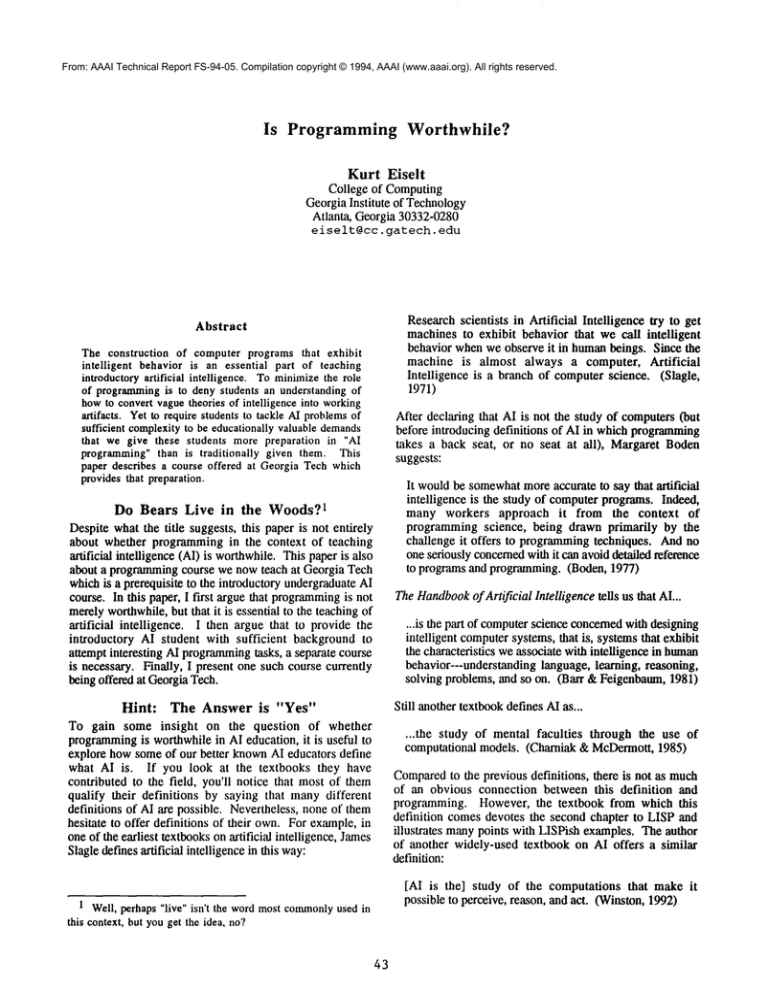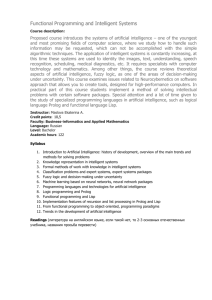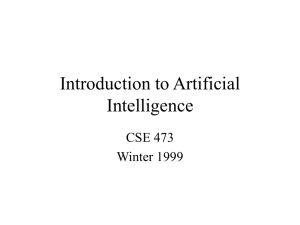
From: AAAI Technical Report FS-94-05. Compilation copyright © 1994, AAAI (www.aaai.org). All rights reserved.
Is
Programming
Worthwhile?
Kurt Eiselt
College of Computing
Georgia Institute of Technology
Atlanta, Georgia 30332-0280
eiselt@cc .gatech.edu
Abstract
The construction of computer programs that exhibit
intelligent behavior is an essential part of teaching
introductory artificial intelligence. To minimizethe role
of programmingis to deny students an understanding of
howto convertvaguetheories of intelligence into working
artifacts. Yet to require students to tackle AI problemsof
sufficient complexityto be educationallyvaluable demands
that we give these students more preparation in "AI
programming"than is traditionally given them. This
paper describes a course offered at Georgia Tech which
providesthat preparation.
1Do Bears Live in the Woods?
Despite what the title suggests, this paper is not entirely
about whether programming in the context of teaching
artificial intelligence (AI) is worthwhile.This paper is also
about a programmingcourse we nowteach at Georgia Tech
whichis a prerequisite to the introductory undergraduateAI
course. In this paper, I first argue that programming
is not
merelyworthwhile,but that it is essential to the teaching of
artificial intelligence. I then argue that to provide the
introductory AI student with sufficient background to
attempt interesting AI programmingtasks, a separate course
is necessary. Finally, I present one such course currently
being offered at GeorgiaTech.
Hint: The Answer is "Yes"
To gain some insight on the question of whether
programmingis worthwhile in AI education, it is useful to
explore how someof our better knownAI educators define
what AI is. If you look at the textbooks they have
contributed to the field, you’ll notice that most of them
qualify their definitions by saying that many different
definitions of AI are possible. Nevertheless, none of them
hesitate to offer definitions of their own. For example, in
one of the earliest textbookson artificial intelligence, James
Slagle defines artificial intelligence in this way:
Research scientists in Artificial Intelligence try to get
machines to exhibit behavior that we call intelligent
behavior when we observe it in humanbeings. Since the
machine is almost always a computer, Artificial
Intelligence is a branch of computer science. (Slagle,
1971)
After declaring that AI is not the study of computers (but
before introducing definitions of AI in which programming
takes a back seat, or no seat at all), Margaret Boden
suggests:
It wouldbe somewhatmoreaccurate to say that artificial
intelligence is the study of computerprograms. Indeed,
many workers approach it from the context of
programming science, being drawn primarily by the
challenge it offers to programmingtechniques. Andno
one seriously concernedwith it can avoid detailed reference
to programs and programming. (Boden, 1977)
The Handbook
of Artificial Intelligence tells us that AI...
...is the part of computerscience concernedwith designing
intelligent computersystems, that is, systems that exhibit
the characteristics we associate with intelligence in human
behavior---understanding language, learning, reasoning,
solving problems, and so on. (Barr & Feigenbaum,1981)
Still another textbookdefines AI as...
...the study of mental faculties through the use of
computational models. (Chamiak & McDermott, 1985)
Comparedto the previous definitions, there is not as much
of an obvious connection between this definition and
programming. However, the textbook from which this
definition comes devotes the second chapter to LISP and
illustrates manypoints with LISPish examples. The author
of another widely-used textbook on AI offers a similar
definition:
[AI is the] study of the computations that make it
possible to perceive, reason, and act. (Winston, 1992)
1 Well, perhaps "live" isn’t the wordmost commonly
used in
this context, but youget the idea, no?
43
The author of this definition puts some apparent distance
between AI and programming,but this same author has also
co-authored a LISP programming tutorial to be used in
conjunction with his textbook. Does this author really
believe that programming and AI are as distant as his
definition implies? The reader is heartily encouragedto leap
to his or her ownconclusion.
Whatthese definitions hold in common
is that they either
specifically
mention programming or the behavior of
computers,
or they come from authors to whom
programmingis clearly very important. In other words,
according to the authors of these introductory textbooks,
understandinghowto create programsthat exhibit intelligent
behavior is not merelyuseful, it is by definition integral to
the understandingof artificial intelligence.
undergraduate computer science curriculum, we have
introduced a new required course which we hope will help to
solve this problem. This course, which is typically taken
by students in their sophomoreyear, but maybe taken as
early as the freshman year, is called "knowledge
representation and processing," and it introduces the student
to four topics: (1) the functional programmingparadigm,
(2) the LISP programming language, (3) software design
issues such as decomposition, modularity, abstraction, and
programmingfor other people versus programmingfor the
computer, and (4) basic knowledge representation and
processing concepts (e.g., lists, trees, relational networks,
dumbsearch, and heuristic search). Twocompanioncourses
introduce topics in object-oriented
programming and
concurrent programming,respectively. Together, these three
courses comprisethe prerequisites for our junior-year course
on programming language concepts. So, while our
The Georgia
Tech Perspective
"knowledgerepresentation and processing" course prepares
At Georgia Tech, all undergraduate computerscience majors
undergraduates
(as well as somegraduate students) for the
are required to take the introductory artificial intelligence
introductory
AI
course, it also serves to introduce these
course. Over the past few years, the laboratory component
students
to
one
of the several different programming
of this course has evolved from one in which students take
paradigms
we
want
them to be exposed to prior to the
existing micro-programs and modify the code to one in
programming
language
concepts course.
which students build these micro-programsfrom scratch.
Wehave only been teaching this course for one year now,
Undoubtedlythere have been somenegative effects of this
change. The instructor and the teaching assistant must work and most of the students whohave taken this course have
not yet taken the artificial intelligence course, so we cannot
harder, both whenthe students are workingon the programs
say muchabout how well prepared these students actually
as well as whenthe programsmust be graded. Furthermore,
building the programsfrom scratch meansthat students may will be. But we can say that before they enter the AI course,
most of these students have demonstrated a good
be exposed to fewer programs than when they were only
understanding of topics such as state-space search and
required to modifyexisting programs. In addition, students
relational networkrepresentations, and they have attempted
complain more about the workload than before, since the
to implementsmall but interesting game-playing programs
laboratory componentis nowdemonstrably more difficult.
using minimax search. Furthermore, most of the students
Finally, students nowcomplainfrequently and vociferously
have
enjoyed learning what is to them a most unusual
that the programmingassignmentsare underspecified.
programmingparadigm, despite the occasional complaint
Despite these drawbacks, most of the AI faculty at
that the course is not practical becausethey will "never get a
Georgia Tech(although not necessarily all of us) agree that
job
writing LISP programs." Not only do we expect that all
the advantages of having the students do a significant
these
students will learn more from their AI course thar~
amount of programming far outweigh the disadvantages.
their
predecessors
did, but that the AI instructors will be able
One of the most difficult problems we face in AI is the
to
cover
more
material
in the AI course than they have in
problem of turning relatively vague and under-specified
past
years.
theories of intelligence into systems that actually do
something which might be considered intelligent behavior.
Conclusion
Thus, the students’ complaints about underspecification axe
appropriate. But the only way that students can appreciate
As defined by the authors of the textbooks that most of us
the vast difference between specifying a compiler and
have used at one time or another for teaching artificial
specifying a natural language understanding system, for
intelligence, the construction of computer programs that
example, is to try (and maybeeven sometimesto fall)
exhibit intelligent behavioris an essential part of AI itself.
construct intelligent programs.
To minimize or completely eliminate programmingin these
This increased emphasis on programmingrequires that we
introductoryartificial intelligence coursesis to denystudents
provide the students with better preparation in the AI
an understanding of how to convert vague theories of
programminglanguage of choice, which at Georgia Tech is
intelligence into workingartifacts. Yet to require students
Common
LISP. Back when our students were required only
to tackle AI problems of sufficient complexity to be
educationally valuable demandsthat we give these students
to modifyexisting programs,it was sufficient that they had
more preparation in "AI programming"than is traditionally
only two weeks of exposure to LISP in a freshman
given them. At Georgia Tech, we believe we have taken a
programming course. Nowhowever, those two weeks of
significant
step toward solving these problems by
LISP instruction prove to be not nearly enough; the students
introducing a ten-week course which introduces the
tend to be frustrated by their lack of knowledgeof the
programming language, and end up spending too much of
functional
programming paradigm, the CommonLISP
their time in the AI course learning LISPinstead of learning
programming language, basic software engineering
AI concepts. As part of a major revision of our
44
principles, as well as someof the fundmnental concepts of
AI programming.
The Course
Syllabus
The "knowledgerepresentation and processing" course was
drawnin part from the classic text by Abelsonand Sussman
(1985), Structure and Interpretation of ComputerPrograms.
In fact, it was the text we originally used for the course, but
we have since dropped the text for two reasons: (1) the
computerscience students did not like the examples, which
seemedbetter oriented toward engineering students, and (2)
the book’s examples were presented in the Schemedialect
while we asked the students to write their programs in
Common
LISP. Belowis the syllabus for this course:
Week 1
Tues
Introduction to the course
motivation--whythis course exists
why LISP?
functional programmingv. procedural
programming
interpreters v. compilers
progranuning for people v. programming
for computers
course requirements and grading
Thurs
Abstraction, reference, and synthesis
Procedures and processes
The procedure as black box
Procedural abstraction
Course Description:
CS 2360 is one of the new
courses in the undergraduate computerscience curriculum,
Week 2
and is intended for relatively new students to computer
science. The goal of this course is not so muchto help you
Tues Function evaluation
learn to write efficient computerprograms,but rather to help
Substitution modelof evaluation
you learn to be efficient computer programmers. Another
Abstract data types
wayof putting this is that you will learn to write programs
Lists: the fundamentaldata structure
for the benefit of people, as opposedto writing programsfor
the benefit of computers. As you will see during this
Thurs Conditionals: makingprocedures flexible
course, these two ideals will often be in conflict. Alongthe
Recursion: makingprocedures repetitive
way, you’ll be introduced to a different paradigm for
linear recursive processesvs. linear iterative
problem-solving and programming than the one you’re
processes
probably most familiar with; this new paradigm is often
the
"shape" of a process
referred to as functional programming,although we’ll stray
tail
recursion and optimizing compilers
far away from the purist’s
approach to functional
programmingin this course. You’ll also becomeintimately
Week 3
aware of program design principles of decomposition,
modularity, transparency, and abstraction. In this sense, this
Tues More recursion
course can be viewed as a software engineering course. At
tree recursion
the same time, you’ll also gain experience with diverse
recursion
templates with examples
methodsof representing information, particularly symbolic
The
myth
of
efficiency
information, as well as different ways of manipulating that
efficient programsv. efficient programmers
information, so you might also view this course as an
algorithmsand data structures course.
Thurs Lambdafunctions: procedures without names
Our main vehicle for exploring this terrain will be the
Proceduresas data
programming language called CommonLISP. Common
Applyand funcall
LISP is the second oldest computer programminglanguage
Applicative programming
currently in widespreaduse, but don’t let the age fool you-some implementations of CommonLISP offer the most
sophisticated
programming environments in existence.
Week 4
LISPis usually closely identified with the worldof artificial
Tues Dataabstraction: an introduction
intelligence, as it is the language most often used in the
Hierarchicaldata structures
development of "intelligent" systems. Yet LISP has also
association lists
gained acceptanceas a tool for the rapid prototyping of other
property lists and hash tables
large systems such as compilers emdoperating systems. In
trees
any case, knowledge of CommonLISP will give you an
graphs
additional tool for solving problems you maybe faced with
directed graphs
in your career.
Tradeoffsbetweenhierarchical and linear
representations
Thurs Midterm Exam 1
45
Week 5
Tues
Traversinghierarchical data structures
Dumbsearch
depth-first with backtracking
Thurs
States and problemspaces
Heuristic search
Gamesearch
Week 6
Tues
Assignmentand local state
Local vs. global state variables
Costs and benefits of variables and assignment
Thurs Iteration: another approachto repetitive procedures
Week 7
Tues
Scoping
lexical vs. dynamicscoping
how scoping impacts assignment
call by value vs. call by reference
The lexical closure
Thurs Midterm Exam 2
Week 8
Tues
Networkrepresentations
relationship to directed graphs
information contained in relationships
Framesand inheritance
extracting inherited information
relationship to objects and tOP
More dumbsearch
breadth-rust search
tradeoffs betweenbreadth-lust and depth-first
Thurs Simple object-oriented programmingin LISP
The CommonLISP Object System (CLOS)
Week 9
Tues
Applicative programmingrevisited
Thurs Macros
Week 10
Tues
Building languages on languages
The mini-Schemeinterpreter
The LISPevaluator: read, eval, print
Thufs
Production systems
rule-based programming
forward- and backward-chaining
Logic, predicate calculus, and deductiveinference
Logic programmingand Prolog
46
References
Abelson, H., & Sussman, G.J. (1985). Structure and
Interpretation
of Computer Programs. New York:
McGraw-Hill,Inc.
Barr, A., & Feigenbaum, E.A. (1981). The Handbook of
Artificial Intelligence:
Volume I. Los Altos, CA."
William Kaufmann,Inc.
Boden, M.A. (1977). Artificial Intelligence and Natural
Man. NewYork: Basic Books, Inc.
Charniak, E., & McDermott, D. (1985). Introduction to
Artificial Intelligence. Reading, MA:Addison-Wesley
Publishing Company.
Slagle, J.R. (1971). Artificial Intelligence:The Heuristic
Programming Approach. NewYork: McGraw-HilLInc.
Winston,P.H. (1992). Artificial Intelligence (third edition).
Reading, MA:Addison-Wesley Publishing Company.





